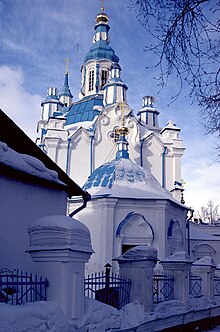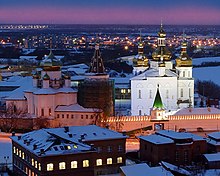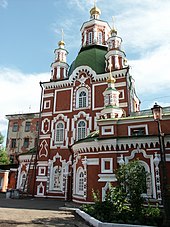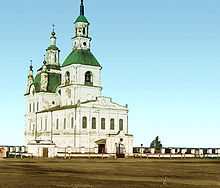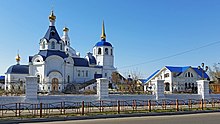
Tobolsk is a town in Tyumen Oblast, Russia, located at the confluence of the Tobol and Irtysh rivers. Founded in 1590, Tobolsk is the second-oldest Russian settlement east of the Ural Mountains in Asian Russia, and was the historic capital of the Siberia region. Population: 100,352 (2021 Census); 99,694 (2010 Census); 92,880 (2002 Census); 94,143 (1989 Census).

Tyumen is the administrative center and largest city of Tyumen Oblast, Russia. It is situated just east of the Ural Mountains, along the Tura River. Fueled by the Russian oil and gas industry, Tyumen has experienced rapid population growth in recent years, rising to a population of 847,488 at the 2021 Census. Tyumen is among the largest cities of the Ural region and the Ural Federal District. Tyumen is often regarded as the first Siberian city, from the western direction.

Kyiv-Pechersk Lavra or Kyievo-Pecherska Lavra, also known as the Kyiv Monastery of the Caves, is a historic Eastern Orthodox Christian monastery which gave its name to one of the city districts where it is located in Kyiv.
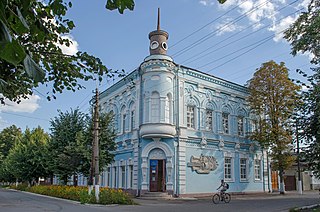
Novhorod-Siverskyi is a historic city in Chernihiv Oblast, northern Ukraine. It serves as the administrative center of Novhorod-Siverskyi Raion, although until 18 July 2020 it was incorporated as a city of oblast significance and did not belong to the raion. Novhorod-Siverskyi is situated on the bank of the Desna River, 330 kilometres (210 mi) from the capital, Kyiv. It hosts the administration of Novhorod-Siverskyi urban hromada, one of the hromadas of Ukraine. 12,375.

Vydubychi Monastery is an historic monastery in the Ukrainian capital Kyiv. During the Soviet period it housed the NANU Institute of Archaeology.

Ukrainian Baroque, or Cossack Baroque or Mazepa Baroque, is an architectural style that was widespread in the Ukrainian lands in the 17th and 18th centuries. It was the result of a combination of local architectural traditions and European Baroque.

Verkhoturye is a historical town and the administrative center of Verkhotursky District of Sverdlovsk Oblast, Russia, located in the middle Ural Mountains on the left bank of the Tura River 306 kilometers (190 mi) north of Yekaterinburg. Population: 8,820 (2010 Census); 7,815 (2002 Census; 8,973 ; 10,900.

The Gate Church of the Trinity is a historic church of the ancient cave monastery of Kyiv Pechersk Lavra in Kyiv, the capital of Ukraine. Originally being built as a Kievan Rus' style church, the Gate Church of the Trinity is now decorated in the Ukrainian Baroque style, having been reconstructed many times through its history.

The Diocese of the Transfiguration at Novosibirsk is a suffragan Latin Church diocese of the Catholic Church in the ecclesiastical province of the Mother of God at Moscow.
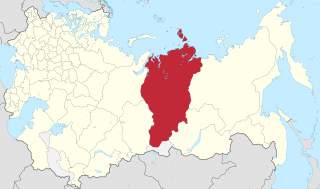
Yeniseysk Governorate was an administrative-territorial unit (guberniya) of the Russian Empire, the Russian Republic, and the Russian SFSR in 1822–1925. It was named after Yeniseysk.
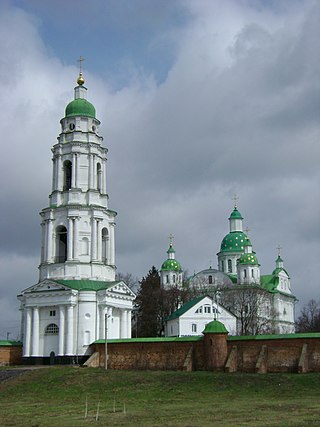
The Mhar Monastery is a male monastery of the Ukrainian Orthodox Church on the bank of the Sula River near Lubny. Originally built by the Ukrainian clergy of the Ecumenical Patriarchate of Constantinople, since the 18th century it belongs to the Russian Orthodox Church.
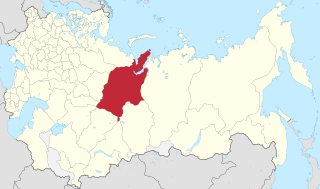
Tobolsk Governorate was an administrative-territorial unit (guberniya) of the Russian Empire, Russian Republic and Russian SFSR located in the Ural Mountains and Siberia. It existed from 1796 to 1920; its seat was in the city of Tobolsk, and from 1919 to 1920, in the city of Tyumen.

Ancient Chernihiv is the National Architecture-Historical Sanctuary located in the north-eastern Ukrainian city of Chernihiv. It was created at first as an affiliate of the National Sanctuary "Sophia of Kyiv". Since August 1, 1967, the site is a separate entity consisting of 34 monuments of architecture.
The Tobolsk Kremlin is the sole stone kremlin in Siberia. It is located in Tobolsk, Tyumen Oblast, Russia.

The Church of the Saviour, also known as the Church of the Image of "The Saviour Not Made by Hands" or shorter Spasskaya Church, is a church in Tyumen, Tyumen Oblast, Russia, located at Lenin Street, 43, in a crossroad between the Chelyuskintsev Street. Built in a late 18th-century Siberian Baroque and early 20th-century neorussian style, the building is one of the oldest and most expressive churches in Siberia, which is under monument protection.

The Transfiguration Cathedral or Saviour-Transfiguration Cathedral is the oldest building in Chernihiv, Ukraine, and one of the few surviving buildings of pre-Mongol Rus. It is located in Dytynets Park.

Abalak is a rural locality and the administrative center of Abalkskoye Rural Settlement of Tobolsky District, Tyumen Oblast, Russia. The population was 806 as of 2010. There are 20 streets.

The Chernihiv Collegium is one of the first educational institution in the Cossack Hetmanate for complete secondary and, subsequently, higher spiritual education, established on the left bank of the Dnieper. In the period of its highest prosperity, the collegium became a major educational and intellectual center and gained fame in Russia as “Chernigov Athens”. In historiography, the Chernihiv Collegium is considered one of the "first offspring" of the Kyiv-Mohyla Collegium. The collegium is located in the center of Chernihiv, on the edge of the rampart of the former fortress, next to the St. Boris and Gleb Cathedral at the Dytynets Park.

Russian Baroque is a term used to describe the Baroque artistic style that emerged in the Russian Tsardom and the Russian Empire during the late 17th and early 18th centuries. This style was mainly seen in Saint Petersburg and Moscow during the reigns of Peter the Great and Elizabeth of Russia.
